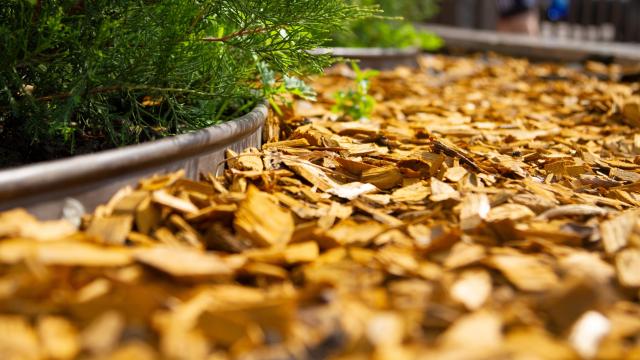The streets in my neighbourhood are dotted with piles of wood chips every few houses, as everyone prepares for “the wintering.” Me, too—I always try to make sure I get a Chip Drop this time of year; four yards of fresh maple were dropped last week in a giant pile in front of my house. Now is the perfect time to get a wood chip delivery, and understanding how wood chips work as mulch will help you understand why.
Chips make a perfect walkway
Wood chips break down into rich, well-aerated compost over time, full of worms and mycellium, and improve any soil they are added to once they’ve composted. Before they break down, they make an excellent base for a walkway, and as such, are what I use between all my beds. Unlike grass or clover, chips are still highly walkable even in the wettest of weather, and you don’t really damage the chips by doing so. While grass and clover certainly feel better on your feet, wood chips certainly don’t feel bad on bare feet, not like gravel or rocks. As a tool in landscaping, the color shift of chips against green grass or wood or cement is a nice break. While the chips compost over time, you can top them off as needed.
Topping your vegetable beds saves water and plant roots
As the wood chips are breaking down, they require nitrogen to do so. If those chips are in your soil or beds, that means they’re actively robbing the soil of nitrogen, and the vegetables and plants growing in that soil that need the nitrogen. However, if they are sitting on top of the soil, they don’t cause that problem. For that reason, chips are an excellent mulch on top of your beds. As summers become hotter, and water more scarce, it’s more important than ever to use mulch to reduce watering and protect plant roots. A few inches of mulch, kept away from the stems of plants, will accomplish that. Simply move the chips out of the way when you need to plant something new. Chips are a lot more stable than say, straw, which can often result in grass in your beds, even though it’s not supposed to. Once the chips have completely broken down, they’re part of the bed as compost.
Mulch all your flower, shrub and tree beds, too
Even your most established trees and shrubs need watering and root protection. Use the chips as a deep mulch, protecting them through an extra cold winter or extra hot summer. Remember, the deeper down those roots are, the more moderate the temperature. Layer on a few inches of chips to create that depth, making sure to stay away from tree trunks and plant stems. Just create a circle of clearance around each.
Fall is the right time
There are two times of year people cut down trees—fall, before winter snow and rain weighs branches down, and spring, as part of spring cleanup. In between, I am always suspicious of why trees are being taken down (disease?). That makes now the perfect time to get a great drop.
Mulch now, before the cold hits. The best part is that whatever chips you don’t use can generally sit and compost all winter, and be in terrific shape come spring. While garden centers have wood chips, I generally use ChipDrop—it’s free and I can specify what kinds of woods I won’t take in my request.

Leave a Reply
You must be logged in to post a comment.